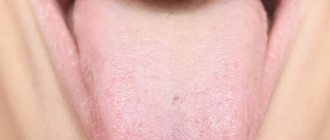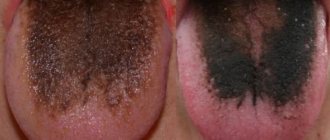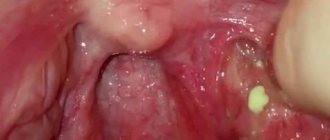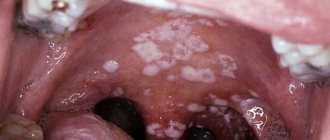What are white dots on the tonsils
Plaque can take the form of single white dots of varying sizes - from one to several millimeters. Their consistency can be soft, cheesy (caseous), dense or hard.
Every day, the tonsils encounter microbes that enter through the nasopharynx. In the lacunae, pathogenic microorganisms come into contact with the epithelium of the tonsils. In response to the penetration of bacteria, local inflammation develops. It activates the immune system and the production of antibodies.
The epicenter of resistance to infection is the follicles of the tonsils. They are groups of lymphoid immunocompetent cells. The result of the struggle is accumulation of destroyed cells and bacteria in the lacunae and at the site of the follicles. Gradually the plugs are impregnated with calcium salts and harden.
The resulting white dots on the tonsils consist of:
- from the remains of dead leukocytes;
- destroyed epithelial cells;
- microbes;
- calcium salts.
Bacterial examination of the contents of plugs reveals streptococci, staphylococci, and pneumococci.
What kind of disease is this and what are its causes?
Chronic tonsillitis is the most common cause of plug formation.
In addition, white lumps on the tonsils may appear:
- with weakened immunity;
- frequent sore throats;
- herpetic infection;
- fungal infection - candidiasis;
- caries;
- viral infections - influenza, ARVI.
With and without fever
The appearance of white spots on the tonsils may be accompanied by an increase in temperature. This is observed:
- with follicular or lacunar tonsillitis;
- influenza and acute respiratory viral diseases;
- herpetic infection;
- exacerbation of chronic tonsillitis.
The tonsils enlarge, their hyperemia and swelling are revealed, their surface loosens.
White spots on the tonsils may appear without fever. This happens:
- with candidiasis;
- with chronic tonsillitis without exacerbation.
To establish the cause of white dots on the tonsils, it is necessary to do a bacteriological analysis of them.
White lumps with an unpleasant odor
With chronic tonsillitis, white lumps with an unpleasant odor appear in the tonsils. They often have a cheesy or hard consistency. They are called tonsilloliths. The putrid odor is caused by the activity of pathogenic microorganisms. The disease occurs without sore throat.
With inflammatory processes in the throat or nasopharynx, tonsillitis increases.
Other symptoms
With exacerbation of chronic tonsillitis, follicular or lacunar tonsillitis, in addition to plaque on the tonsils, there is a sore throat, difficulty swallowing, enlargement and tenderness of the submandibular lymph nodes. Symptoms of intoxication appear: headache, weakness, lack of appetite. At night there may be heavy sweats and sleep disturbances.
With acute respiratory viral infections, patients complain of body aches, pain in the muscles and when moving the eyeballs, cough, runny nose, and chest congestion.
Preventive measures
Most often, white plaque signals a decrease in the body’s immune function and the beginning of an inflammatory process. Hypothermia or heavy exercise can trigger an exacerbation.
To prevent this effect, it is recommended to maintain physical fitness with basic morning exercises. You should choose clothes in accordance with the season and weather conditions.
After the end of the summer season, it is appropriate to take complex vitamin formulations that will prevent a decrease in protective functions.
You can compensate for the deficiency of microelements necessary for normal life by including a large amount of vegetables, fruits, fish and meat (low-fat varieties) in your diet.
After ARVI in a child
Children suffer from acute respiratory viral diseases quite often. This is due to:
- immaturity of the child’s immune defense mechanisms;
- high crowding in children's groups.
Sometimes after an acute respiratory viral infection, white dots or spots are found on the child’s tonsils, enlargement, swelling of the tonsils, and redness of the palatine arches. This indicates the addition of a bacterial infection and the development of a sore throat. In this case, you should immediately seek medical help.
Timely and correct treatment of sore throat will protect the child’s body from complications.
A white coating may appear on the child’s tonsils without fever. This happens when oral thrush occurs. Thrush is a fungal disease caused by pathogenic fungi of the genus Candida. Candidiasis often develops during antibiotic treatment. The diagnosis is made based on examining a smear from the tonsil under a microscope. Specific antifungal drugs are used in treatment.
White spots in a child's throat
In infants, the main cause of whitish plaque on the oral mucosa is candidiasis. This is due to the complete sterility of the baby’s skin and mucous membranes at birth.
Therefore, by inhaling air, receiving mother’s milk or formula from a bottle, or putting his fingers into his mouth, the baby populates the oral cavity with microflora. Sometimes in this way he becomes infected with a fungal infection, which causes unpleasant symptoms.
On the throat of a preschool child, a white coating most often forms against the background of acute tonsillitis.
Sore throat is an exclusively bacterial disease, fraught with serious complications, therefore it must be treated with the utmost care and not neglect antibiotics.
A red throat with white dots in a child rarely indicates the presence of diphtheria, since most modern people are vaccinated against this extremely dangerous infectious disease.
- Thick white snot in adults and children - causes and treatment
Attention
If you suspect the development of this pathology, you should immediately call an ambulance and go to the hospital inpatient department for the administration of anti-diphtheria serum. This can save a child's life.
In any case, if a child has spots on the tonsils, especially against the background of fever and poor general health, he should be seen by a doctor immediately.
How to remove white dots
In order to remove white lumps in the tonsils, use local antiseptic bactericidal agents. They are available in a wide range in the form of sprays, lozenges or tablets. Rinsing helps a lot. Traditionally, solutions of soda, table salt with iodine, furatsilin, chamomile and sage decoctions are used for this. You can use a solution of Metrogyl, Miramistin.
It is impossible to clean the tonsils from white lumps at home. This is done by an otolaryngologist by vacuum extraction of plugs or washing the tonsils with antiseptic solutions.
It is not recommended to remove a white dot containing pus from the tonsil on your own. In the acute period of the disease, this is prohibited.
Folk remedies
- Furacilin solution. Rinse at least 4 times a day.
- Saline solution. You can add a few drops of iodine.
- Chamomile decoction.
- Sage decoction.
- Honey. Dissolve 1 teaspoon no more than 1 time per hour.
- Lemon, citrus. Relieve pain and fight dangerous microorganisms.
- Garlic. When chewed, juice is released that kills harmful bacteria.
- Onion. Grind in a blender, breathe deeply over the pulp for 5 minutes.
Self-medication can be dangerous, because an unpleasant symptom occurs due to various reasons. Before using a folk remedy, consult your doctor.
Correct treatment
For the treatment of sore throat, or exacerbation of chronic tonsillitis, in an adult the following is prescribed:
- Broad-spectrum antibiotics.
- Irrigation or washing of the tonsils with an antiseptic solution.
- Gargling with bactericidal agents.
- Complex vitamin therapy to improve immunity.
- Physiotherapy.
White lumps on the tonsils are removed by vacuum cleaning the tonsils.
Accurate fulfillment of all doctor’s orders contributes to a quick recovery. Incorrect or self-treatment can lead to the development of complications.
About congestion in the throat
Every person has experienced pain, discomfort and a feeling of congestion in the throat many times in their lives.
This is due to the fact that a common cold, which is accompanied by swelling of the pharyngeal mucosa, irritates the nerve endings, creating pain and soreness in the throat. In many cases, an acute process, provided that immunity is not reduced, can be well treated at home in such a way as: gargling, drinking plenty of fluids. And yet, treating an inflammatory disease of the pharynx on your own at home is wrong, and therefore, against the background of such a disease, a chronic disease of the pharynx can develop: pharyngitis, chronic tonsillitis, and even chronic laryngitis. In certain cases, symptoms may appear: anxiety, a lump in the throat and bad breath.
Video treatment of chronic tonsillitis without surgery, 12:47 min.
When you have a sore throat, it is very common to look at your mouth in a mirror. Upon examination, you can see purulent plugs in the throat, white-yellow lumps of a cheesy nature with a rather unpleasant odor, emerging from the mucous membrane of the side walls of the pharynx. Such formations are called caseous plugs, which emerge from the lacunae of the palatine tonsils.
If you suddenly notice plugs in your throat of this nature, then you most likely have chronic tonsillitis. This disease is caused by inflammation in the palatine tonsils. The palatine tonsils are the same tonsils, a collection of lymphoid tissue that is limited from the lateral walls of the pharynx by a capsule. A special feature of the palatine tonsils is their anatomical structure.
Treating throat congestion
Congestion in the throat and bad breath can be so distressing that patients are often ready to resort to any measures, even removal of the tonsils (tonsillectomy). Such a solution in certain cases is very acceptable, but the point is that any operation must be seriously justified. Sometimes, having rushed to remove the tonsils and upset the anatomy and the natural protective mechanisms of the pharynx, in the near future a person may encounter a form of chronic pharyngitis, which is very difficult to treat and intensively worsens the quality of life. That is why, if you have plugs in your throat, do not under any circumstances delay removing your tonsils.
Congestion in the throat is not an indication for tonsillectomy, taking into account all the canons of otorhinolaryngology. With the right approach to treating purulent plugs in the throat, you can do without surgery, solving the problem in a conservative way . The ENT-Asthma clinic has developed and successfully used an effective method for treating chronic tonsillitis, consisting of a set of procedures. All actions are aimed, first of all, at eliminating all the important links in the pathogenesis of this disease, which allows you to actually get rid of congestion in the throat, preserving the tonsils.









